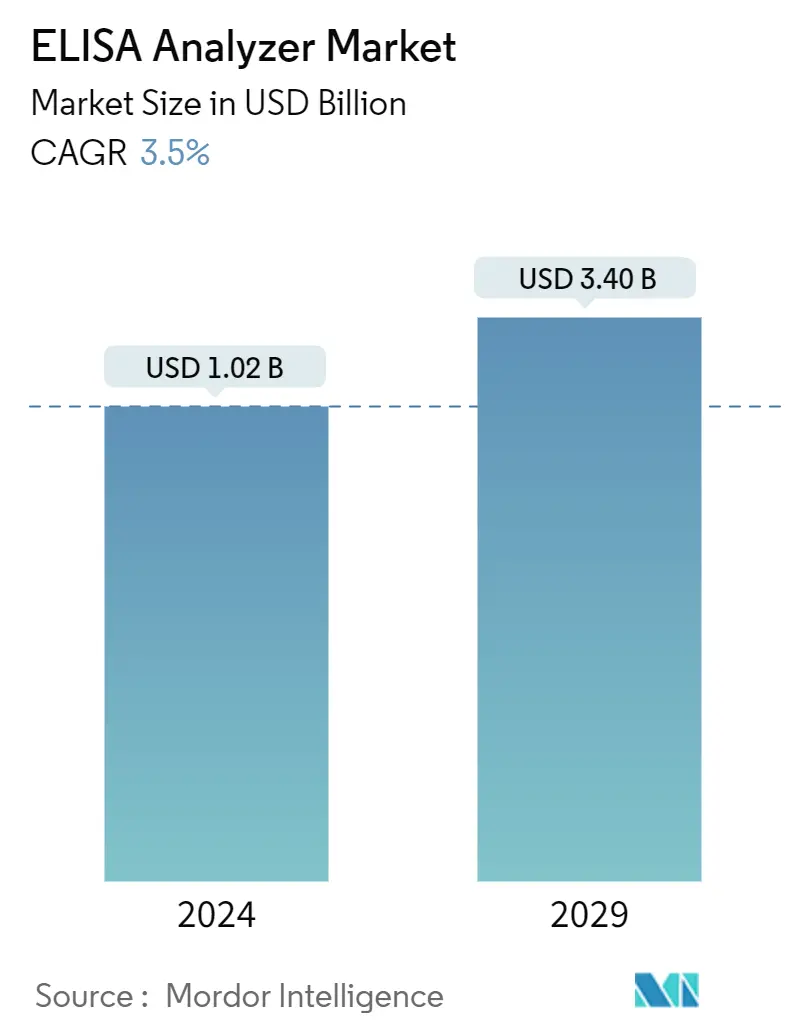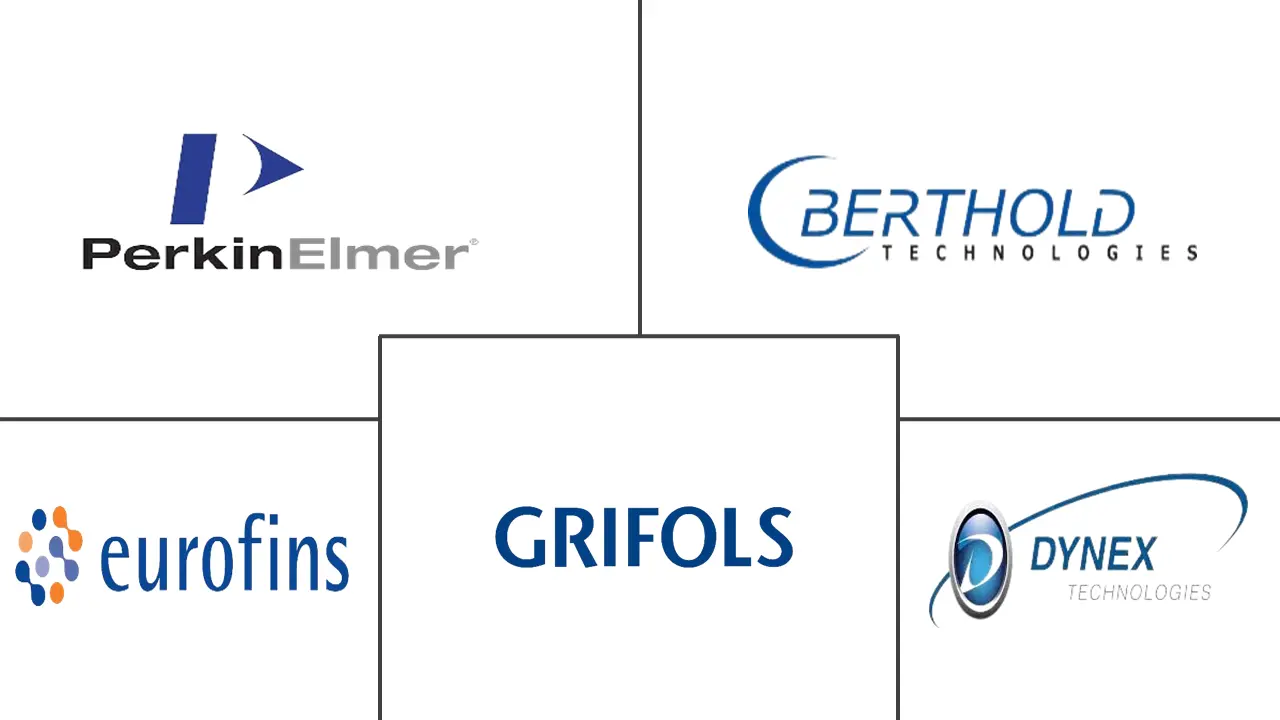Market Size of ELISA Analyzer Industry

| Study Period | 2019 - 2029 |
| Market Size (2024) | USD 1.02 Billion |
| Market Size (2029) | USD 3.40 Billion |
| CAGR (2024 - 2029) | 3.50 % |
| Fastest Growing Market | Asia-Pacific |
| Largest Market | North America |
| Market Concentration | Medium |
Major Players
*Disclaimer: Major Players sorted in no particular order |
ELISA Analyzer Market Analysis
The ELISA Analyzer Market size is estimated at USD 1.02 billion in 2024, and is expected to reach USD 3.40 billion by 2029, growing at a CAGR of 3.5% during the forecast period (2024-2029).
The major factors that are expected to drive market growth are the widespread prevalence of infectious diseases and cancer and the rising demand for technologically advanced systems. Also, the rise in demand for automated and portable ELISA systems is projected to drive industry expansion over the coming years.
The surge in the prevalence of infectious diseases is expected to bolster the demand for ELISA analyzers, as ELIZA analyzers have a crucial role in detecting infectious diseases. For instance, according to the data published by the Joint United Nations Program on HIV and AIDS (UNAIDS), in August 2023, approximately 39.0 million people globally were living with HIV in 2022 compared to 38.7 million in 2021.
As per the same source, around 1.3 million people were newly diagnosed with HIV globally in 2022. Similarly, as per data published by the World Health Organization (WHO) in July 2022, approximately 67,000 new cases of hepatitis C and 10,000 cases of hepatitis B are reported in the United States every year. Thus, the surge in infectious disease led to a surge in ELISA testing, which, in turn, led to a rise in demand for ELISA analyzers, thereby driving the growth of the market.
Also, ELISA is employed to quantify antibody titers used to evaluate immunogenicity during vaccine development. For instance, according to the January 2024 update from Gyros Protein Technologies AB, immunoassays, including ELIZA analyzers, have a significant role in characterizing vector titer, vaccine titer, affinity, and purity of vaccine. Hence, the rise in vaccine development activities around the globe leads to a surge in demand for ELISA analyzers, thereby driving the growth of the market.
For instance, according to the November 2023 data of the Vaccines Europe, there were 103 vaccine candidates in the Vaccines Europe members’ pipeline. Among them, most vaccines are being developed to manage infectious diseases. Thus, the robust pipeline of vaccine candidates is projected to bolster the demand for ELIZA analyzers during the forecast period.
In addition, pharmaceutical companies such as GSK PLC and Sanofi have many vaccine candidates in the pipeline. For instance, Sanofi has 10 vaccine candidates in its pipeline, according to the latest updates at the Q2 2022 results meeting held in July 2022. Hence, the surge in vaccine development activities leads to a rise in demand for ELISA analyzers, thereby driving the growth of the market. However, the lack of skilled professionals and the low detection limit of existing technology is expected to hinder the market growth during the forecast period.
ELISA Analyzer Industry Segmentation
As per the scope of the report, ELISA analyzers are analytical instruments that perform a basic function needed to process an ELISA. These functions include reagent dispensing, microplate washing, incubation, and absorbance measurement.
The ELISA analyzers market is segmented by type of operation, modality, application, end user, and geography. Based on the type of operation, the market is segmented into automated ELISA analyzers and semi-automated analyzers. Based on the modality, the market is segmented into bench-top and stand-alone. Based on application, the market is segmented into vaccine development, immunology, drug monitoring, the pharmaceutical industry, and others. Based on end users, the market is segmented as diagnostic laboratories, pharmaceutical and biotechnology companies, contract research organizations, and other end users. The report also covers the market sizes and forecasts for the ELIZA analyzer market in major countries across different regions. For each segment, the market size is provided in terms of value (USD).
| By Type of Operation | |
| Automated ELISA Analyzer | |
| Semi-Automated Analyzer |
| By Modality | |
| Bench-top | |
| Stand-alone |
| By Application | |
| Vaccines Development | |
| Immunology | |
| Drug Monitoring and Pharmaceutical Industry | |
| Other Applications |
| By End User | |
| Diagnostic Laboratories | |
| Pharmaceutical and Biotechnology Companies | |
| Contract Research Organizations | |
| Other End Users |
| Geography | ||||||||
| ||||||||
| ||||||||
| ||||||||
| Rest of the World |
ELISA Analyzer Market Size Summary
The ELISA analyzer market is poised for steady growth, driven by the increasing prevalence of infectious diseases and cancer, alongside the rising demand for automated and portable systems. The market experienced a dual impact from the COVID-19 pandemic, with a surge in demand for analyzers due to their use in COVID-19 testing, while simultaneously facing challenges as other infectious disease testing saw a decline. The market's expansion is further supported by the growing vaccine development activities, where ELISA analyzers play a crucial role in quantifying antibody titers. Despite the positive outlook, the market faces hurdles such as a shortage of skilled professionals and the limitations of existing technologies.
North America is expected to lead the market, fueled by a high prevalence of infectious diseases requiring ELISA testing and the presence of key industry players offering advanced automated analyzers. The region's growth is bolstered by the availability of sophisticated diagnostic solutions and a robust healthcare infrastructure. The market is characterized by a consolidated landscape with a few major companies dominating, such as Dynex Technologies Inc., Eurofins Scientific, and PerkinElmer Inc. Recent strategic moves, including mergers and product launches, indicate a focus on enhancing automation and expanding product offerings, which are likely to drive further growth in the ELISA analyzer market.
ELISA Analyzer Market Size - Table of Contents
-
1. MARKET DYNAMICS
-
1.1 Market Overview
-
1.2 Market Drivers
-
1.2.1 Rising Incidence of Infectious Diseases
-
1.2.2 Rising Demand for Automated and Portable ELISA Systems
-
-
1.3 Market Restraints
-
1.3.1 Lack of Skilled Professionals and Low detection Limit of Existing Technology
-
-
1.4 Porter's Five Force Analysis
-
1.4.1 Threat of New Entrants
-
1.4.2 Bargaining Power of Buyers/Consumers
-
1.4.3 Bargaining Power of Suppliers
-
1.4.4 Threat of Substitute Products
-
1.4.5 Intensity of Competitive Rivalry
-
-
-
2. MARKET SEGMENTATION (Market Size by Value - USD)
-
2.1 By Type of Operation
-
2.1.1 Automated ELISA Analyzer
-
2.1.2 Semi-Automated Analyzer
-
-
2.2 By Modality
-
2.2.1 Bench-top
-
2.2.2 Stand-alone
-
-
2.3 By Application
-
2.3.1 Vaccines Development
-
2.3.2 Immunology
-
2.3.3 Drug Monitoring and Pharmaceutical Industry
-
2.3.4 Other Applications
-
-
2.4 By End User
-
2.4.1 Diagnostic Laboratories
-
2.4.2 Pharmaceutical and Biotechnology Companies
-
2.4.3 Contract Research Organizations
-
2.4.4 Other End Users
-
-
2.5 Geography
-
2.5.1 North America
-
2.5.1.1 United States
-
2.5.1.2 Canada
-
2.5.1.3 Mexico
-
-
2.5.2 Europe
-
2.5.2.1 Germany
-
2.5.2.2 United Kingdom
-
2.5.2.3 France
-
2.5.2.4 Italy
-
2.5.2.5 Spain
-
2.5.2.6 Rest of Europe
-
-
2.5.3 Asia-Pacific
-
2.5.3.1 China
-
2.5.3.2 Japan
-
2.5.3.3 India
-
2.5.3.4 Australia
-
2.5.3.5 South Korea
-
2.5.3.6 Rest of Asia-Pacific
-
-
2.5.4 Rest of the World
-
-
ELISA Analyzer Market Size FAQs
How big is the ELISA Analyzer Market?
The ELISA Analyzer Market size is expected to reach USD 1.02 billion in 2024 and grow at a CAGR of 3.5% to reach USD 3.40 billion by 2029.
What is the current ELISA Analyzer Market size?
In 2024, the ELISA Analyzer Market size is expected to reach USD 1.02 billion.

